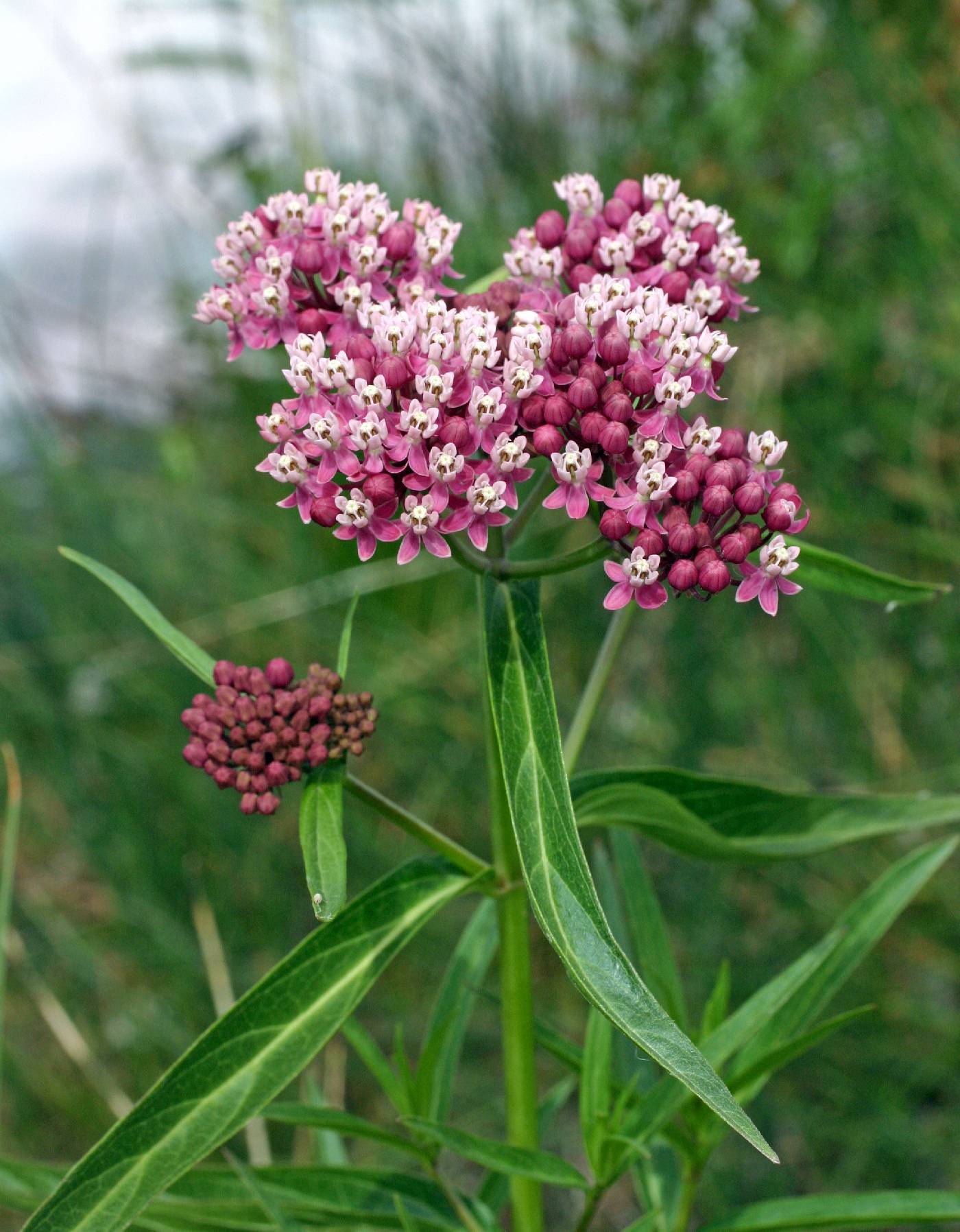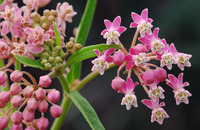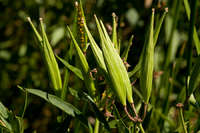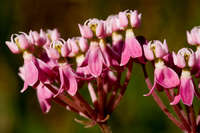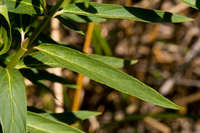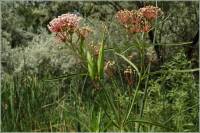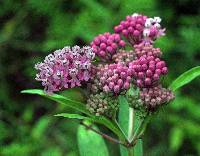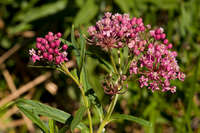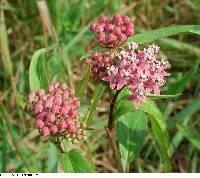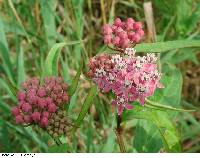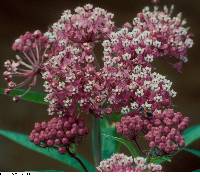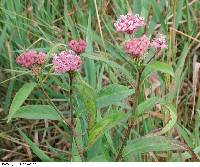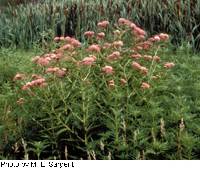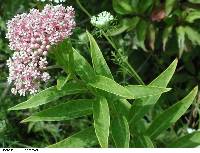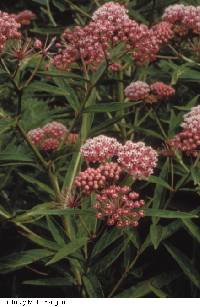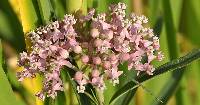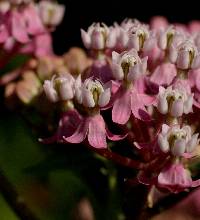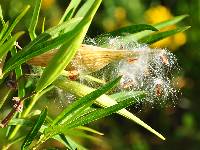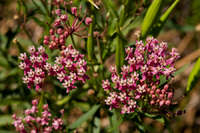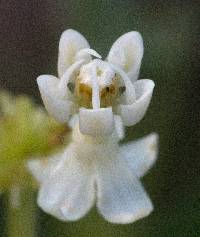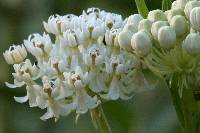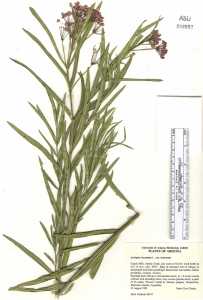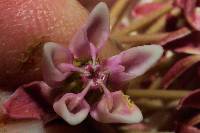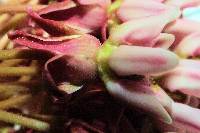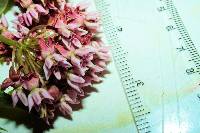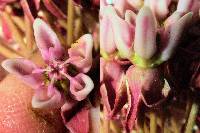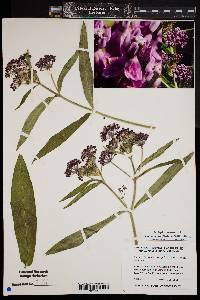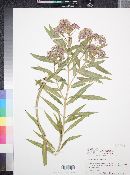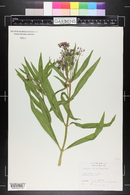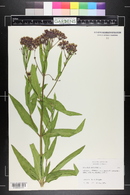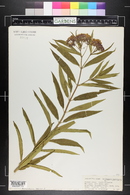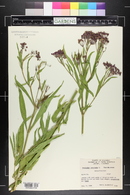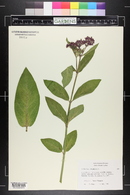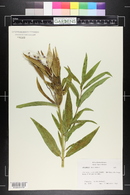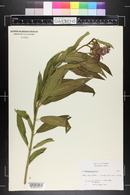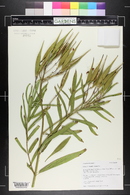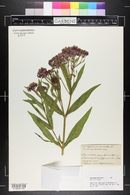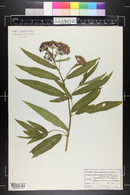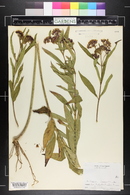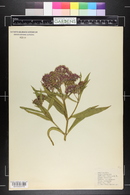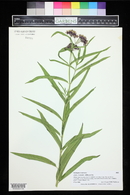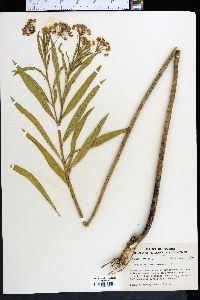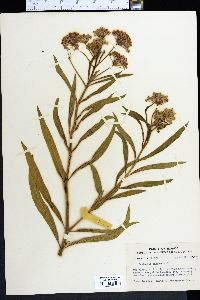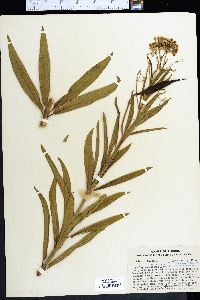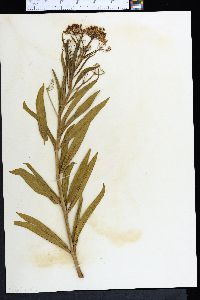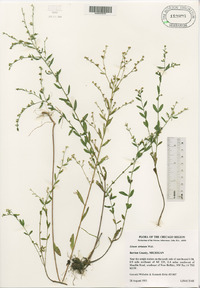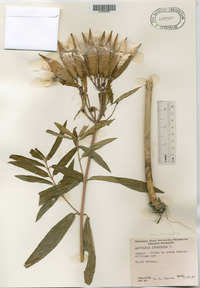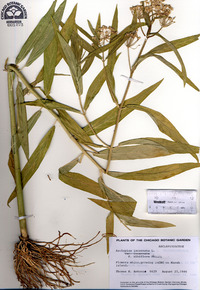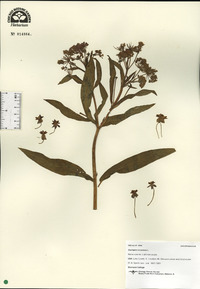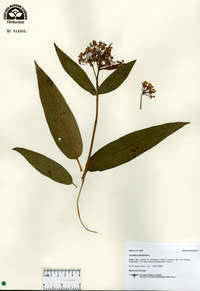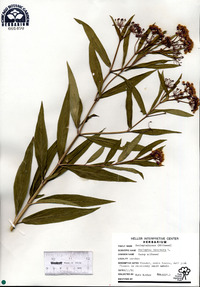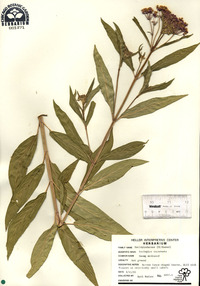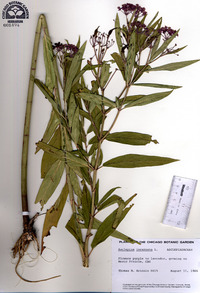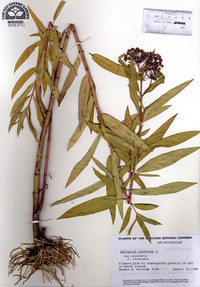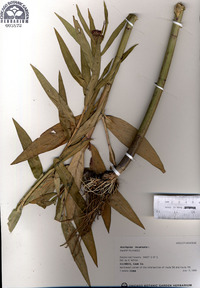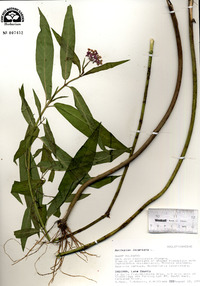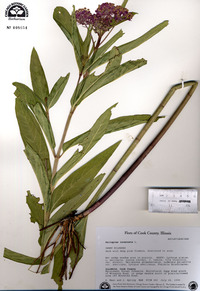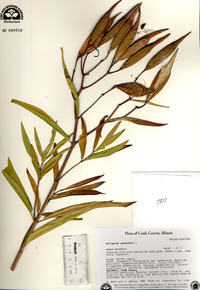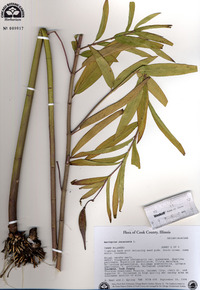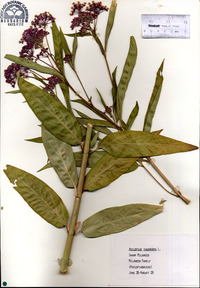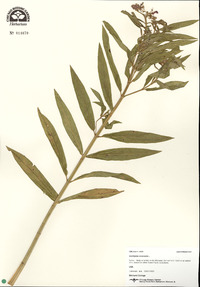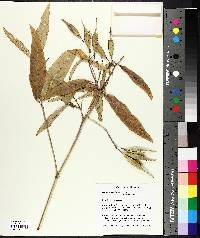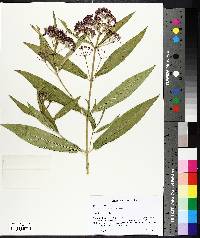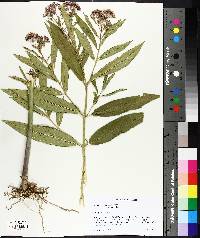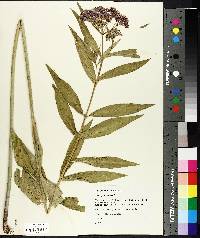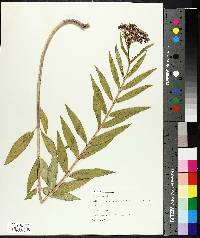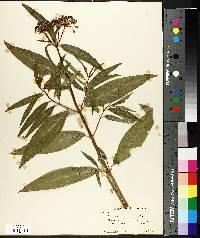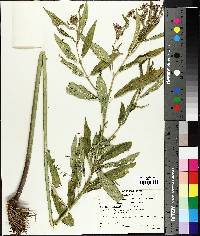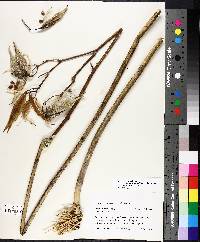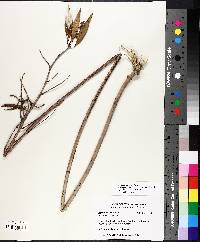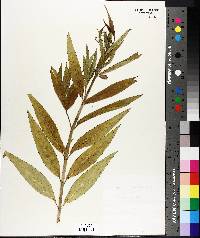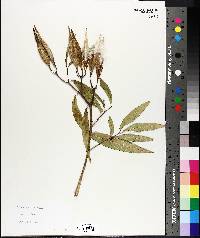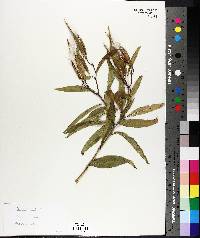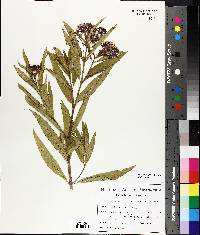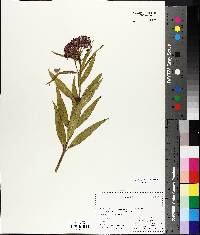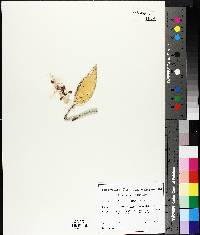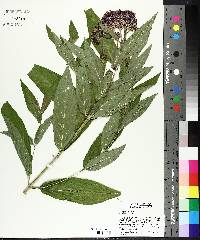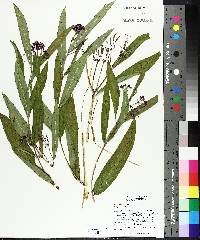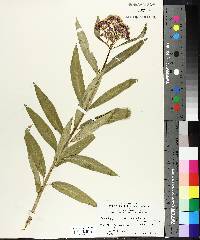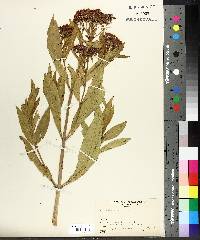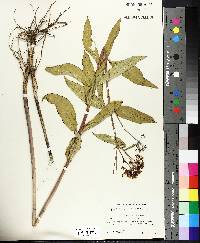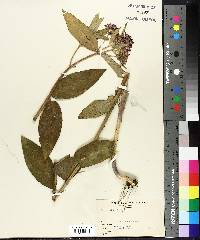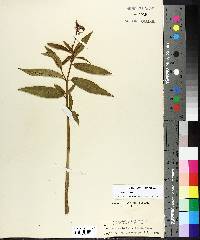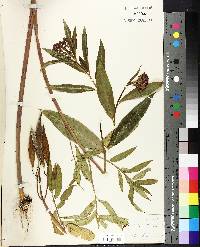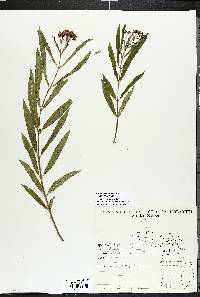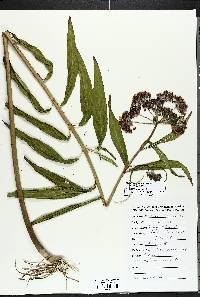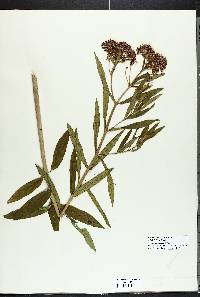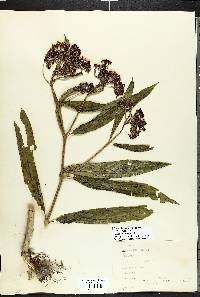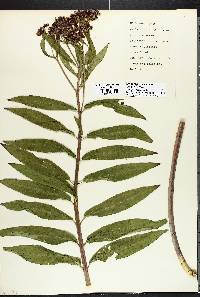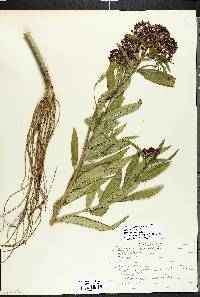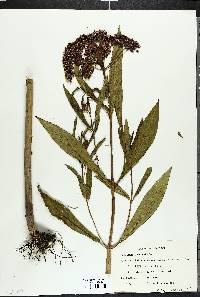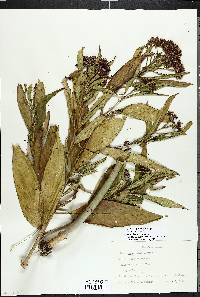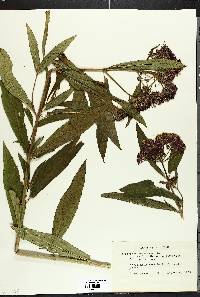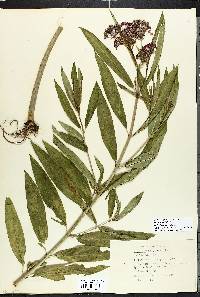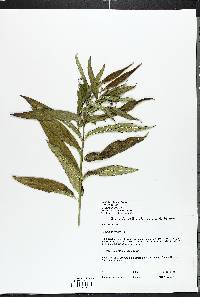
|
|
|
|
Family: Apocynaceae
Swamp Milkweed
[Asclepias incarnata var. longifolia] |
Erect, stout, to 1.5 m, branched above; lvs lanceolate to oblong or linear-oblong, usually acuminate, at base acutish to subcordate; umbels usually several or many; cor pink to red (white), the lobes 4.5-6 mm; hoods 2.5-3 mm, about equaling the gynostegium, the lateral margins entire, divergent from near the base; horn subulate, incurved, much surpassing the hood; 2n=22. Open swamps, ditches, and wet prairies; N.S. to Fla., w. to Sask., Utah, and N.M. June-Aug. Var. incarnata, with nearly the range of the sp., but not common in the Atlantic seaboard states, is sparsely and inconspicuously hairy to essentially glabrous, and the stems are usually repeatedly branched. Var. pulchra (Ehrh.) Pers. largely replacing var. incarnata in N.S., N. Engl., and the coastal states southward, is evidently hairy and seldom much branched, with mostly broader lvs more abruptly contracted at base. Gleason, Henry A. & Cronquist, Arthur J. 1991. Manual of vascular plants of northeastern United States and adjacent Canada. lxxv + 910 pp. ©The New York Botanical Garden. All rights reserved. Used by permission. Plant: perennial herb, tall, stout; stems erect, branching from the upper nodes, to 150 cm tall, finely pubescent in lines above the petioles; milky sap Leaves: opposite, the petioles 3-8 mm long, the blades linear-lanceolate to narrowly elliptic- or oblong-lanceolate, 7-15 cm long, 5-10 mm broad, attenuate at apex, attenuate to abruptly acute at base, sparsely pubescent above and on the veins below INFLORESCENCE: UMBELS lateral in the upper portion of the stem, typically paired at the upper nodes, finely pubescent, ca. 3 cm broad, the peduncles ca. 4 cm long Flowers: small; calyx lobes ca. 2 mm long; corolla bright purple-pink, the lobes ca. 5 mm long; hoods drying white, erect-ascending, ovoid-oblong, 2.5-3 mm long, 1.3-1.6 mm broad along the sloping apex, about as long as the gynostegium, obtuse-rounded above, the horns digitate, attached near the base of the hoods, exserted ca. 1.5 mm and arching over the stigma head; anther wings 1.6-1.7 mm long; corpusculum ca. 0.3 mm long, the pollinia ca. 1 mm long Fruit: FOLLICLES erect on erect pedicels, 6-7 cm long Misc: wet, flat, grassy meadow; 1500 m (5000 ft); Aug REFERENCES: Sundell, Eric. 1994. Asclepiadaceae. J. Ariz. - Nev. Acad. Sci. Volume 27, 169-187. Woodson 1954, Sundell 1993 Duration: Perennial Nativity: Native Lifeform: Forb/Herb General: Herbaceous perennials from short roots, 40-150 cm tall, can be very branched and generally tall and stout; stems appearing smooth but with minute sparse hairs. Leaves: Opposite, with ovate-elliptic to linear-lanceolate petiolate leaves, an acute apex and obtuse to cordate base, 5-15 cm long, 0.5-4 cm wide, the petioles less than 1 cm long. Flowers: Umbels paired at upper nodes but solitary below, can be many flowered, the peduncle 1.5-7 cm long, the flowers rather small, finely pubescent, calyx lobes about 2 mm long, the corolla bright purple-pink, lobes about 5 mm long, the hoods dry white and erect 2.5-3 mm long, and less than 1.5 mm wide, the horns digitate attached near the base of the hoods, exserted 2.5 mm over stigma head. Fruits: Erect follicle, fusiform, 6-9 cm long and about 1 cm thick, smooth, glabrous to generally pilosulose, seeds oval 7-10 mm long, coma about 2 cm long. Ecology: Found in swamps, marshes and cienega edges, low fields and pastures, along rocky stream beds and openings in pine to pine-oak woodlands; elevation range in the Southwest is 3,500-6,500 ft (1067-1981 m); flowers June to October. Distribution: Widespread across the central and northeastern United States, populations exist as far west as UT and NM; south to Coahuila, MEX. Notes: Common in the northeast and central United States and known from a handful of locations in NM and one collection in s AZ. Flowers sweet-scented. Etymology: Asclepias is named for the Greek god of healing Asklepios, while incarnata means flesh colored. Synonyms: None Editor: SBuckley 2014 Cronquist, A., Holmgren, A., Holmgren, N., Reveal, J., & Holmgren, P. (1983). Intermountain Flora Volume 4—Subclass Asteridae (except Asteraceae). Key to Incarnatae IMF: 3. Leaves mostly opposite but sometimes 3 or 4 at some nodes, lanceolate to narrow-lanceolate, (5) 10-25 (60) mm broad; anther-head 1.7-2.3 mm high.................................................A. incarnata 3. Leaves, at least most of them, whorled, the main leaves linear to linear-lanceolate, 1-8 (15) mm broad; anther-head 1.3-1.7 mm high..........................................................................................4 4. Inflorescences often paired in the upper nodes; corolla-lobes grayish-pink to rose, rarely white' column 1-1.5 mm high; ................................................................................A. fascicularis 4. Inflorescences usually solitary in the upper nodes; corolla-lobes white, sometimes yellow to cream or purple-tinged; column 0.6-1.1 mm high;....................................................A. subverticillata From Flora of Indiana (1940) by Charles C. Deam Indiana Coefficient of Conservatism: C = 4 Wetland Indicator Status: OBL Diagnostic Traits: principal leaves opposite, lance-oblong to lanceolate, petiolate; pedicles recurved; corolla pink or rose; fruits puberulent, narrowly fusiform. |
|
|
|

